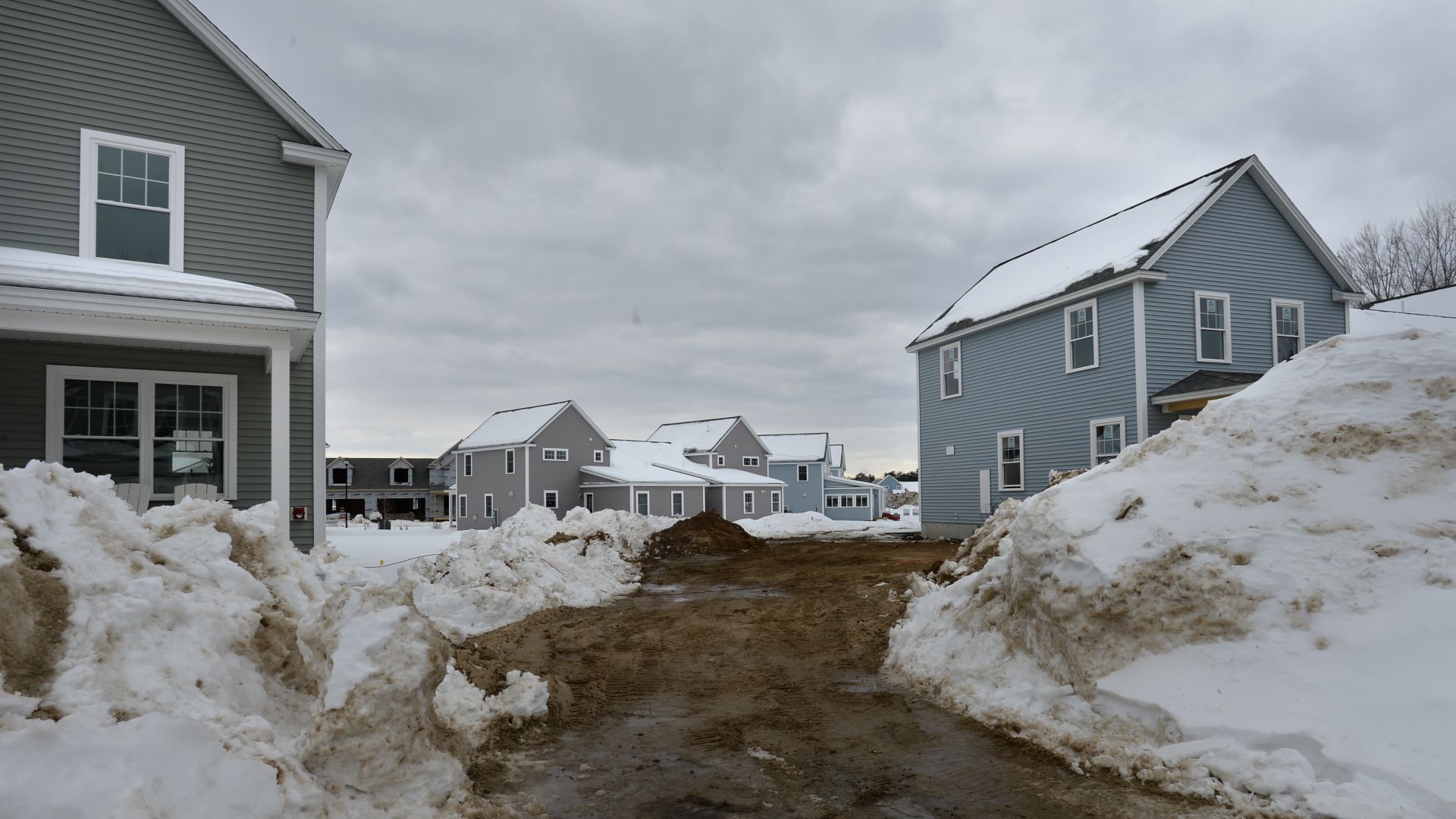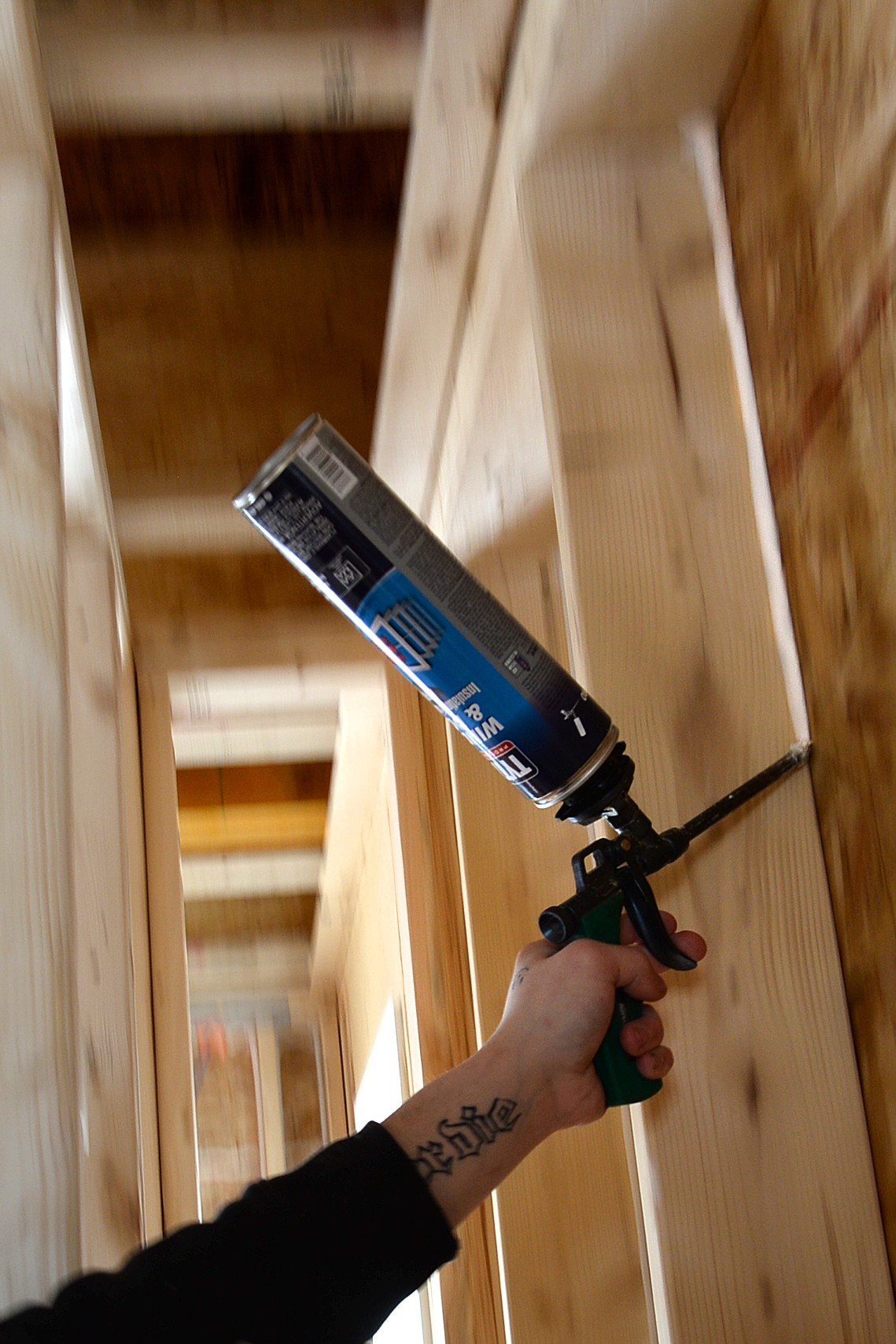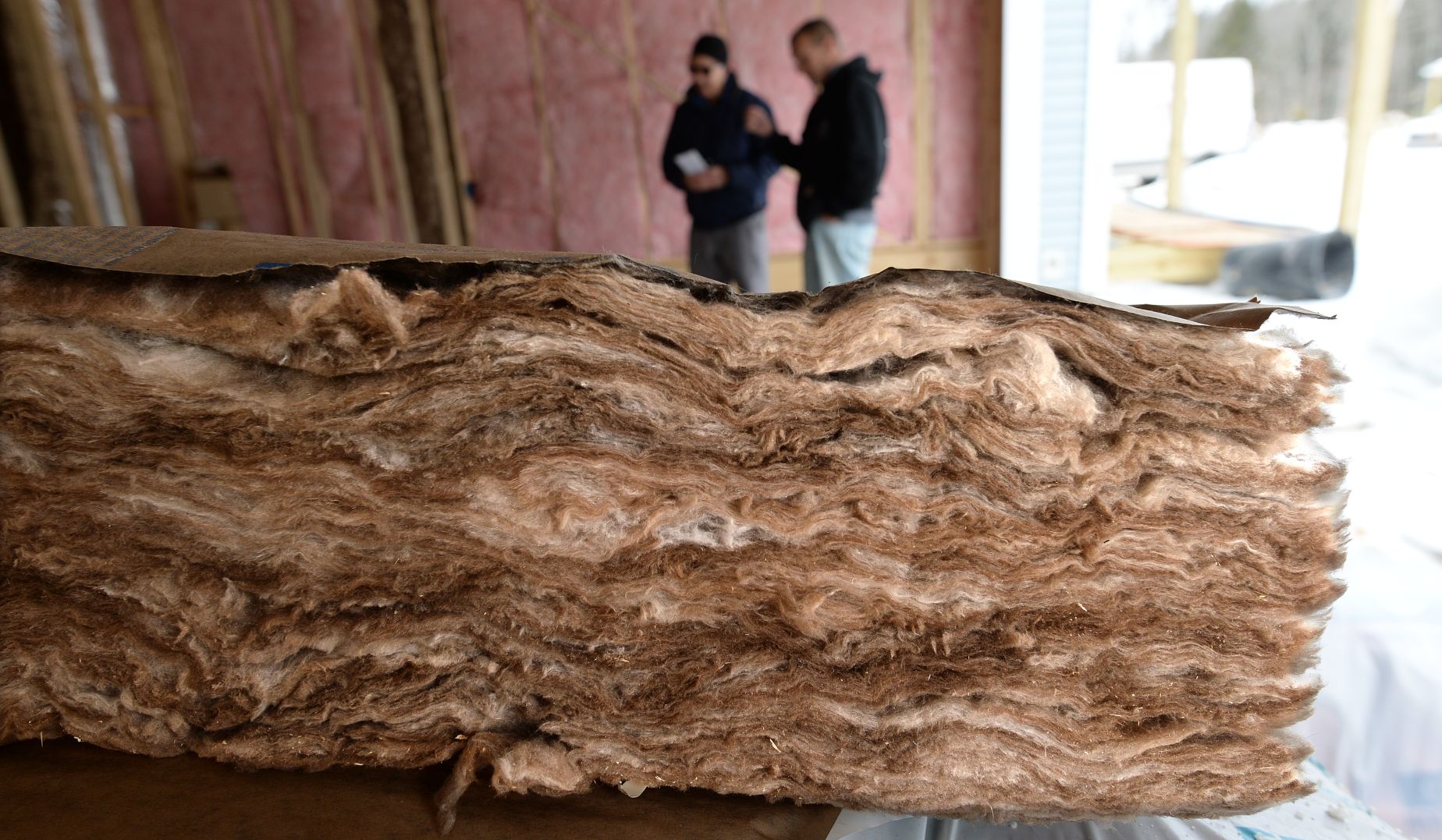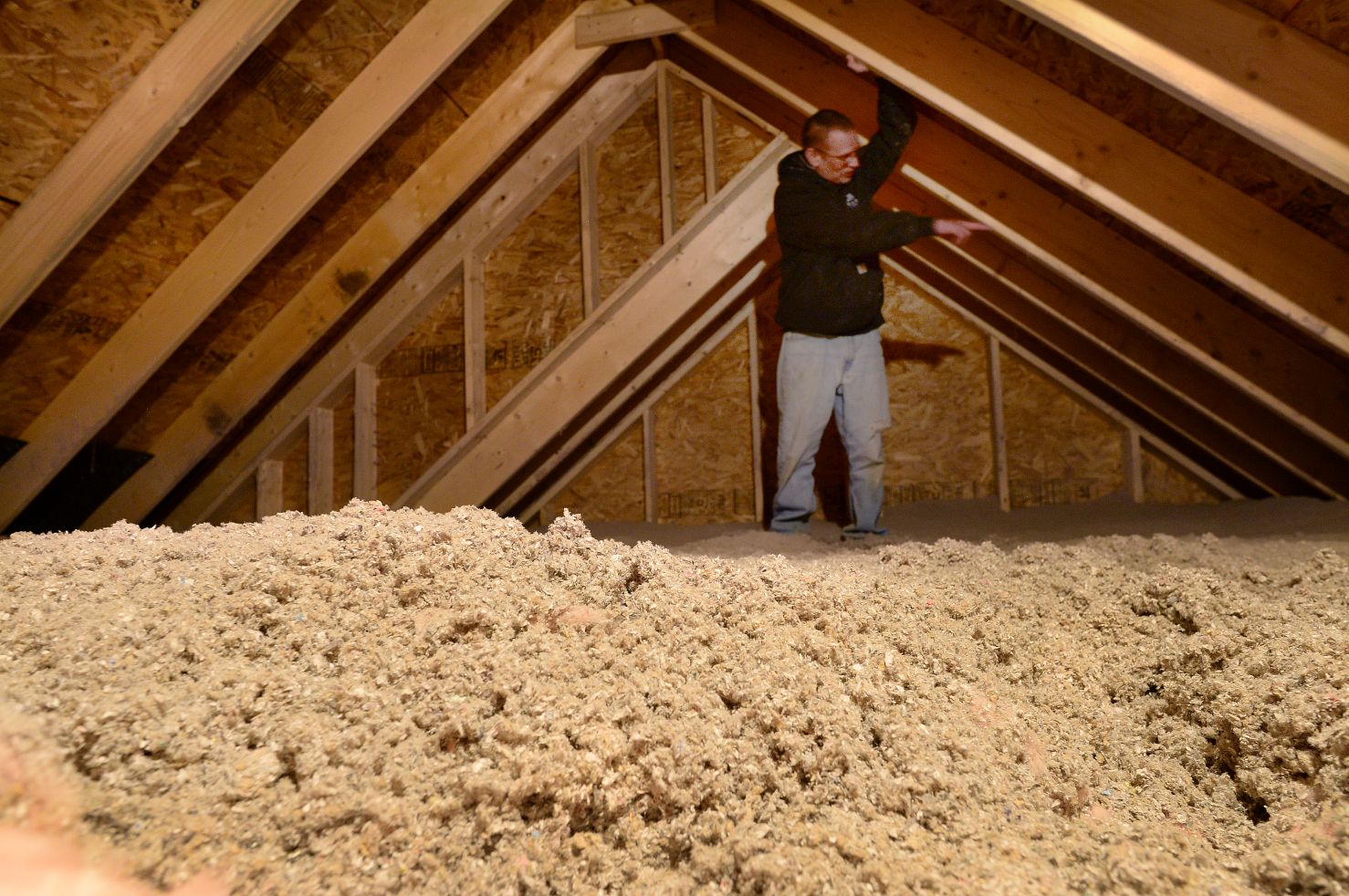It’s a safe bet that new residents of The Cottages at Winding Ridge in Gorham won’t be spending much time in their attics. After climbing through the scuttle hatch in a bedroom closet, they’d have to wade through 14 inches of gray, blown-in cellulose insulation covering the ceiling joists.
That thick blanket is one strategy home builders use to meet Maine’s current energy code for new construction, which requires ceilings to have an R-value of 49, a measure of a material’s resistance to heat loss.
The problem is, the space where the pitched roof meets the exterior wall is less than 14 inches high. To insulate all the way to the eaves and not block ventilation, builders may need to use advanced framing techniques to raise the roof truss. That costs more money.
Now a new cost is coming to the attic.
Starting in April, builders statewide are being asked to stretch — to R60. That’s an unprecedented mandate in Maine and could require up to 20 inches of insulation, depending on the material.
It’s happening after the volunteer board that oversees the Maine Uniform Building Energy Code (MUBEC) voted last December to adopt the 2021 version of International Energy Conservation Code.
The IECC is a model code used by many states and municipalities to set minimum energy standards for new construction. The 2021 edition is sometimes called the “stretch code” because insulation levels and other specs go beyond the previous levels from 2015.
Three Maine communities already require builders to follow the stretch code — Portland, South Portland and Freeport.
The stretch code is a hot topic among home builders, with R60 being the headline. And in attics across Maine this year, meeting the new code will stretch builders in opposite directions, with top state policy goals at either end.
On one side is energy efficiency.
Maine winters are cold and summers are getting warmer. Residents struggle with above-average heat and electricity costs, which hit record levels in 2022 and 2023. Better insulation means lower year round energy bills. And with southern Maine in a post-pandemic building boom, it makes sense for these new homes to be as energy efficient as possible.
On the other side is affordability.
Maine’s home prices are high and aren’t easing. The median price in Maine shot up 50 percent between 2020 and 2024, according to MaineHousing. It hit $390,350 in January. In Cumberland County, where Gorham is located, the price was $595,000. Many building materials, too, have become more expensive since the pandemic.
Meanwhile, the state is nudging builders to erect 84,000 new homes statewide over the next five years. To put a dent in the housing shortage, it makes sense for new homes to be as affordable as possible.
The debate over energy efficiency versus affordability is a national issue, but in Maine, there’s a quirky, rural-urban dynamic. Although the code applies statewide, enforcement is optional in towns with fewer than 4,000 residents. And under the banner of affordability, there’s a bill in the Legislature this session to exempt much of the state from being covered by the new standards.
A Portland suburb, Gorham has more than 18,000 residents. But the 2021 code won’t have a direct impact on The Cottages at Winding Ridge. The project is set to be completed this year under the existing energy code.
The extra ceiling and wall insulation needed to meet the 2021 code would have added $15,000 to a home that will list in the $550,000 range, according to Michael McDonald, the site supervisor for Cottage Advisors, a Massachusetts-based home developer. McDonald said he’s willing and able to comply with whatever the new code says, but he wonders about cost-effectiveness.
“I know it adds expense to a unit and I’m trying to build on a budget,” McDonald said. “But do you get a return on the dollar?”
Is an efficient home afforadable?
Calculating return on the dollar. It’s a tricky equation, because the costs of building materials and labor are always changing, as are energy prices. That hasn’t stopped stakeholders from crunching the numbers.
Moving to the new code is cost-effective for residential buildings in Maine, according to a study done for the federal Department of Energy under the Biden administration. The 2021 code would cut energy costs by 23.5 percent compared to the current (2015) code, the study found, saving $978 on an average annual utility bill. It would pay for itself in roughly four years and trim carbon dioxide emissions over 30 years equal to taking 85,810 cars off the road.
“I think the incremental cost of upgrading to the new code isn’t as much as people think it is,” said Michael Stoddard, executive director of Efficiency Maine. “You’re talking about multi-hundred thousand dollar buildings. And then a little more cost for insulation and air sealing.”
Stoddard, who serves on the board that oversees MUBEC, said failing to adopt the strongest code, or exempting more communities from enforcement, would be unfortunate trends.
“By backsliding on these building codes, we’re dooming Maine homeowners to excessively high energy bills for as long as they own the homes,” he said. “And the second buyer, they should know that when they invest in a home, it’s insulated to minimum standards.”

But the value of insulating beyond a certain level doesn’t make economic sense, according to the Home Builders and Remodelers Association of Maine, which cited research from its national arm. It calculated that the R60 standard would take more than 50 years to pay for itself, with a point of diminishing returns: The first three inches of fiberglass insulation cut heat loss in half. With 15 inches, heat loss is reduced by 96 percent.
“R60 in the ceilings yields diminishing returns and no real cost benefits and only increases home costs,” the home builders wrote in response to the new rule.
“People are screaming that we don’t have housing affordability,” said Carl Chretien of Chretien Construction in Saco. “You have to find the sweet spot.”
Chretien, who represents homebuilders on the board overseeing MUBEC, said his group would rather have seen the state adopt the very latest code — which is the 2024 version — but wait until 2026 to roll it out. The 2024 code drops ceiling insulation back to R49, but gives builders more flexibility by giving them alternative pathways to compliance, such as installing EV chargers or solar-ready wiring. The 2024 edition, however, wasn’t available when the board began its review.
Plugging leaks
While insulation levels attract attention, a more subtle but just as important metric also is addressed in both the current and pending energy codes — air leakage. Tiny cracks and seams along walls and foundations allow cold outside air to be pulled into a building, where it’s heated before escaping through the roof.
Builders must follow an updated testing protocol with a piece of equipment called a blower door. The goal is to reduce air movement to no more than three changes an hour, which is two or three times lower than in a typical older home.

Building a tighter house takes time and attention to detail. In Gorham, insulation workers last month were air sealing a three-bedroom unit.
Carefully, they ran beads of expanding foam along every seam where studs and floor plates meet the wall sheathing. They filled pipe and wire intrusions inside the walls with a fire-rated spray foam. They used another spray foam product to plug the spaces around window and door frames.
Residents won’t see any of this. But they’ll enjoy a draft-free home and lower heating and cooling bills.
“The big thing is air sealing and the blower door test,” said Randy Poulton, a retired building professional who serves on the board. “That really cuts down on the cost of heating.”
Poulton said he voted for the 2021 code, but would have rather seen Maine stick with the current, 2015 version.
“It’s plenty good enough and it was just the minimum,” he said. “What we’ve done is drive up the cost of building a house far above the energy savings.”
Getting up to code
The energy code is a set of guidelines for new buildings and additions created by the International Code Council in 2000. It establishes minimum efficiency standards tailored to eight climate zones. Most of Maine is in Climate Zone 6. Aroostook County is in Zone 7, but the requirements basically are the same.
The code is updated every three years to reflect evolving best practices in the building industry. All but seven states use some version of the code.
The Maine Legislature first voted to adopt the IECC code in 2007. It has since gone through various updates. More recently, the board and technical advisers spent 18 months updating the code and proposing amendments. It was a complicated process, with competing input from stakeholders including environmental groups, green builders, mainstream home builders, state government and insulation manufacturers.
Not surprisingly, energy codes have become a partisan issue.
Earlier this year, the National Association of Home Builders and 15 states with Republican leaders sued the federal Department of Housing and Urban Development over requirements in the 2021 code, which they said would add $22,000 to the price of a new home.
In Maine, Chretien said he felt the Governor’s Energy Office, representing Democrat Gov. Janet Mills, pushed for the 2021 edition without any amendments, based on a promise of federal money from the Biden administration.
A “conversation” over the energy code mandate?
With the new code set to take effect April 7, there’s still an effort to tinker with the outcome. A Republican lawmaker has presented a bill that he said could make housing more affordable by striking the enforcement requirement in more rural Maine towns.
Rep. Jack Ducharme, R-Madison, said some constituents in his town (population 4,760) complain that they have to comply with the code, while residents just across the Kennebec River in Anson (population 2,300) do not.
His bill, L.D. 445, would raise the population level of communities that need to enforce the code from 4,000 to 10,000. The bill had a public hearing Feb. 27.
“I put in the bill with the idea that we’d have a conversation about it,” said Ducharme, who is a real estate broker in Skowhegan. “I put in 10,000 just as a discussion point.”
Maine has more than 480 municipalities. Critics who testified at the hearing said the change would effectively cut the number of Mainers covered by the code from 64% to 34% — making enforcement mandatory in only 22 communities. It defeats the goal of MUBEC, they said, which is to set uniform standards statewide.

Maine’s real estate industry is split on the proposal.
The Maine Association of Realtors supported it. With demand for housing at an all-time high, the group said, L.D. 445 strikes the right balance. It would boost construction and recognize the staffing constraints of small town code enforcement officers, while maintaining local choice for how standards are enforced.
The Maine Real Estate & Development Association opposed the measure. It noted that the change wouldn’t just remove small rural towns, but also diverse service centers such as Brewer, Topsham and Old Orchard Beach. The group said it was open to “a deep conversation” about relaxing some of the standards, but wants to retain the uniformity that it said makes development easier.
The enforcement wild card
A missing piece to any discussion of the energy code is an assessment of how it’s being applied statewide today. No one really knows to what degree builders in towns under 4,000 are following the code.
It’s hard to say whether a small contractor who puts up a couple of houses a year is building to the same energy standards as a company that builds subdivisions. A survey of code officials slated for later this year might shed some light, according to Mark Stambach, one of the board members overseeing MUBEC.
“I get the feeling that reputable builders are doing everything they can to build to the code,” said Stambach, the code enforcement officer in Lisbon, population 9,700.
Contributing to the problem, Stambach said, is the high turnover of code officials in today’s job market, coupled with the need for more training and education. State officials hope to start addressing the training and education shortfalls later this year, when the building codes and standards program is moved from the Fire Marshal’s Office to the recently-created Office of Community Affairs.
But with housing prices at record levels, tension between affordability and energy savings won’t go away. It’s a maxim in real estate that buyers want features they can see and enjoy. Is it more desirable to put a few thousand dollars into granite countertops in the kitchen, or more insulation in the attic?







